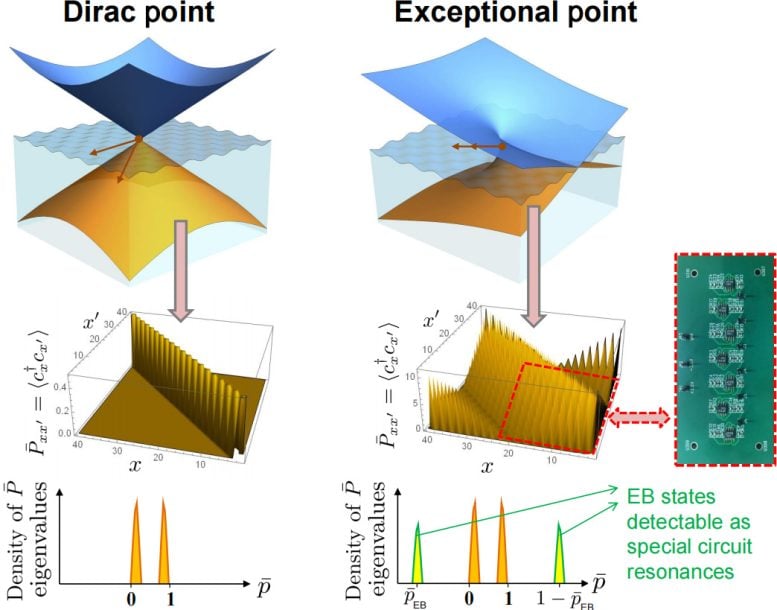
By Science China Press August 18, 2024
Collected at: https://scitechdaily.com/redefining-quantum-limits-physicists-unlock-the-secret-of-elusive-negative-entanglement-entropy/
Researchers have successfully demonstrated negative entanglement entropy using classical electrical circuits as stand-ins for complex quantum systems, providing a practical model for exploring exotic quantum phenomena and advancing quantum information technology.
Entanglement entropy quantifies the degree of interconnectedness between different parts of a quantum system. It indicates how much information about one part reveals about another, uncovering hidden correlations between particles. This concept is essential for advancing quantum computing and quantum communication technologies.
To understand what negative entanglement entropy means, we will first need to know what entanglement and entropy are.
Entanglement and Entropy in a nutshell
Imagine you have two coins. Normally, if you flip one coin, it doesn’t affect the outcomes of flipping the other. But in the quantum world, particles can become “entangled,” meaning their states are linked. If two coins are entangled, the entanglement rule can be such that when one coin is flipped into a head, the other coin must show a tail. In essence, knowing the result of one restricts the possible outcomes for the other.

On the other hand, entropy is a concept of statistical physics that measures the disorder or uncertainty of a system. For example, a messy room has high entropy because things are scattered all over, and it is hard to predict where any specific item is. A tidy room has low entropy because everything is in its place, making it easy to find things.
Entanglement Entropy
When putting together, “entanglement entropy” measures how much information you lose about one part of a system if another part of the system suddenly becomes inaccessible i.e. is truncated by a so-called “entanglement cut”. Intuitively, the more highly entangled the two parts are, the more information will be lost.
One simple analogy to understand entanglement entropy is to imagine a pair of socks. You put one sock in one drawer and the other sock in another drawer. If the socks are “entangled”, then knowing the color of the sock in one drawer immediately tells you the color of the sock in the other drawer. Here, two situations can arise:
- High Entanglement: If the colors of the two socks are almost perfectly correlated, then knowing the color of one sock gives you almost perfect information about the other. In particular, if one sock suddenly becomes inaccessible, one would also lose knowledge of the color of the other sock.
- Low Entanglement: If the socks’ colors are essentially uncorrelated, then knowing the color of one sock does not make one more certain about the color of the other. In particular, if one sock suddenly becomes inaccessible, there will not be any more uncertainty i.e. entropy regarding the color of the other sock.
Negative Entanglement Entropy
Conventional quantum mechanics have only been concerned with conservative systems where particles and energy do not get destroyed or made. However, intriguing new physics arises when this restriction is lifted – in the sock analogy, where socks can be removed or added to the system. Such systems as known as “Non-Hermitian” systems.
In non-Hermitian systems, the concept of entanglement needs to be modified, because information can also be lost when the number of particles changes. In particular, gaining new socks and their information can be construed as giving out a negative amount of sock information to others. This leads to the new concept of negative entanglement entropy.
While the theoretical recipe for achieving negative entanglement entropy in a non-Hermitian quantum system has been thought of since a few years ago, actually observing negative entanglement in quantum experiments cannot be easily done. This is due to significant challenges in manipulating intricate quantum states in a way that they gain or lose energy, while at the same time also measuring how entangled they are.
Exceptional bound states and negative entanglement entropy in electrical circuits
Reporting in Science Bulletin, physicists from Singapore and China have experimentally observed elusive states that mathematically possess negative entanglement entropy. Instead of using a quantum system, the research team employed a non-quantum (or classical) electrical circuit to generate a ‘sandbox’ system that is mathematically identical to a system with negative entanglement, but without the challenges accompanying true quantum systems. Such classical electrical circuits are built with easily available electronic components such as resistors, capacitors, and operational amplifiers, without the need for ultralow cryogenic cooling and high-precision lasers using needed in a quantum system.
“EB states are highly robust and exhibit prominent measurable signatures, thus greatly facilitating their physical realization in relatively simple classical networks such as electrical circuits without the need for fine-tuning,” said Professor Xiangdong Zhang from the Beijing Institute of Technology whose research team provided the experimental measurements of EB states using electrical circuits.
“A very pertinent question that we have always wanted to answer is: can the esoteric negative entanglement behavior manifest in realistic experiments? In this work, we provide an affirmative “yes” through the novel concept of exceptional bound (EB) states,” said the project leader Assistant Professor Ching Hua Lee from the National University of Singapore.
“EB states are special states that provide the key fingerprints for negative entanglement,” said Professor Haiyu Meng from Xiangtan University, co-author of this work. Whenever the host system becomes very sensitive due to the non-Hermiticity, EB states may emerge as a direct consequence of negative entanglement.
“This work suggests classical electrical circuits as a new hunting ground for the search of exotic quantum phenomena which are otherwise challenging to realize using atoms and material crystals. Due to their ease of fabrication, electrical circuits may offer a low-cost sandbox for designing and prototyping devices useful for future quantum technology”, said Assistant Professor Yee Sin Ang from the Singapore University of Technology and Design, co-author of this work.
The demonstration of negative entanglement entropy can have a profound impact in many areas of physics and engineering, particularly quantum information technology. Going forward, EB states and electrical circuits can be used to probe exotic physics in higher dimensions, thereby ushering a new fertile arena for the triple interplay of topological, non-Hermitian, and EB physics.
Reference: “Experimental observation of exceptional bound states in a classical circuit network” by Deyuan Zou, Tian Chen, Haiyu Meng, Yee Sin Ang, Xiangdong Zhang and Ching Hua Lee, 29 May 2024, Science Bulletin.
DOI: 10.1016/j.scib.2024.05.036

Leave a Reply